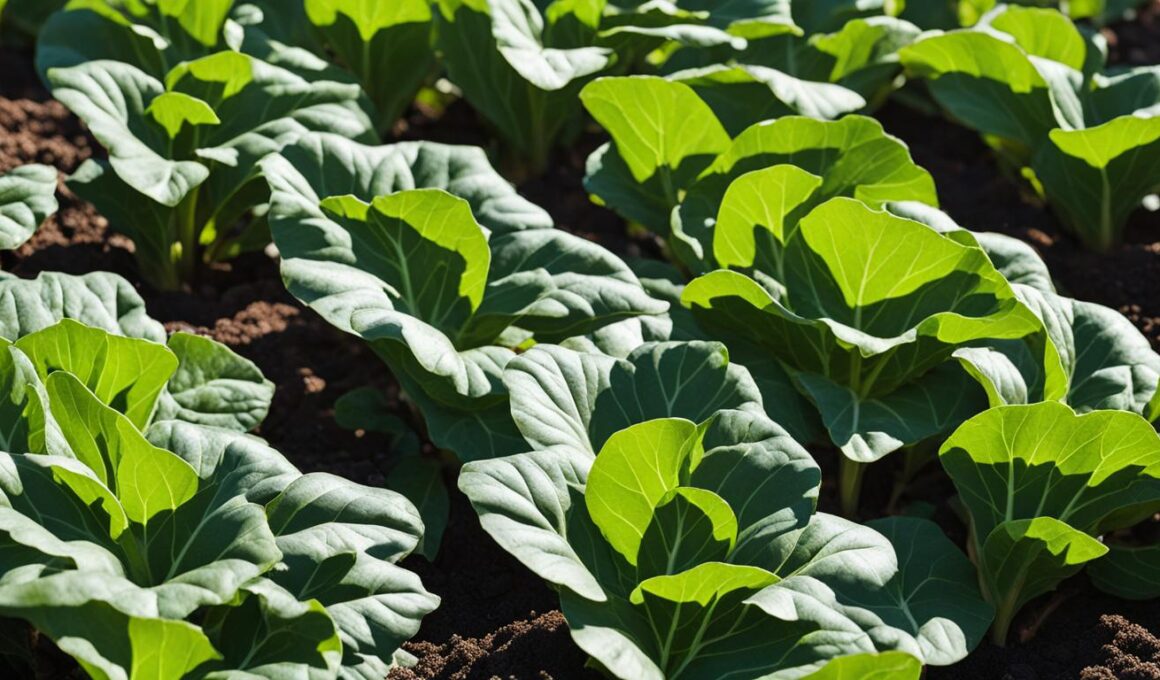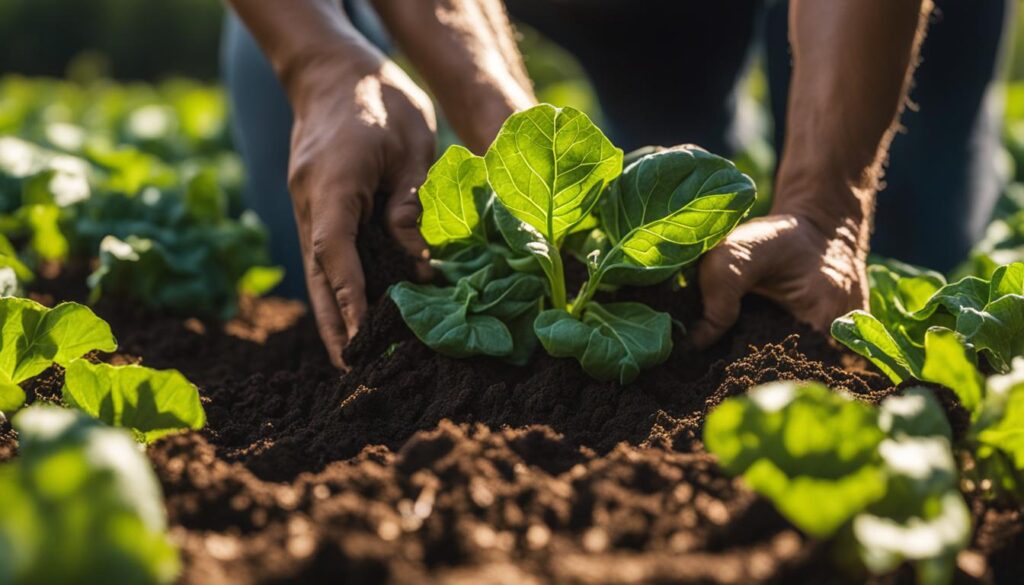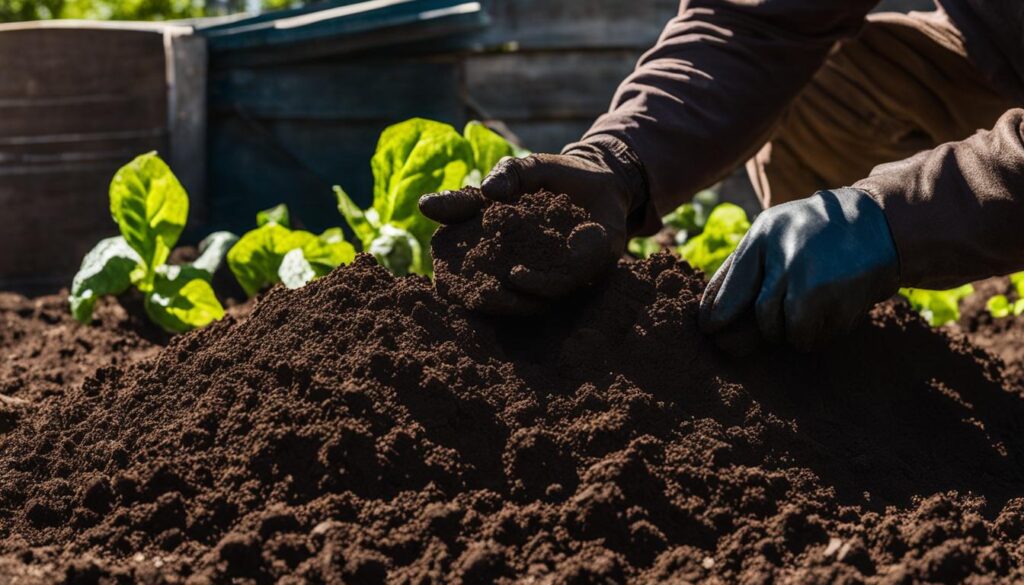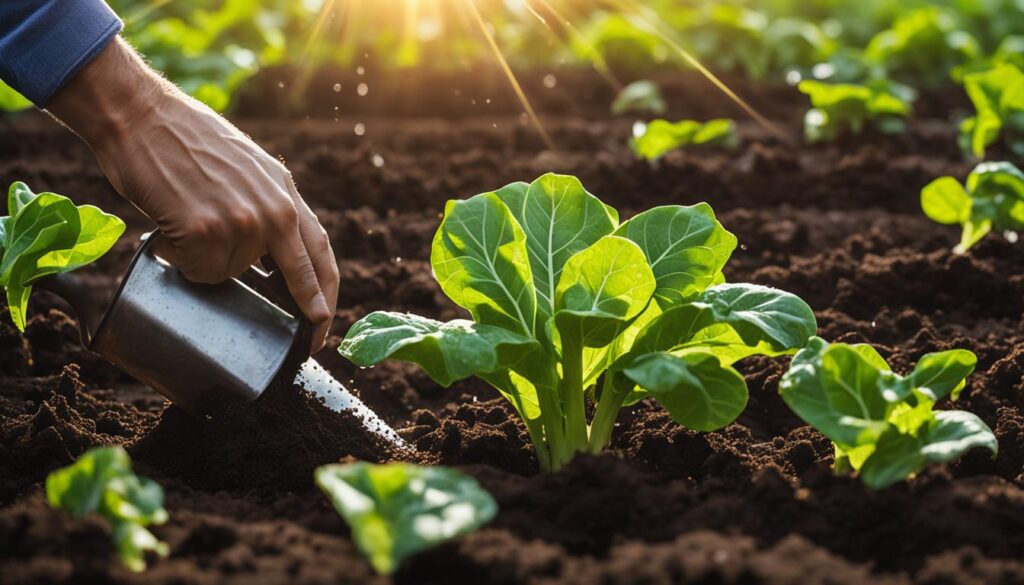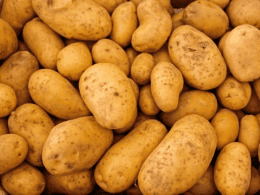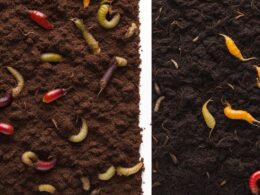Beloved for their versatility and resilience, collards are a staple in Georgia vegetable gardening. Discovering the best time to plant collards in Georgia is essential for maximizing collard greens yield and making the most of the collard planting season Georgia has to offer. Delve into the rich history and unique characteristics of collards while exploring planting techniques, suitable varieties, and practical care tips to help you achieve a bountiful harvest.
Key Takeaways
- Collards are prevalent in Georgia due to their ability to thrive in cool-season climates and tolerate a wide range of temperatures.
- Plant collards in early spring for a summer harvest or midsummer to reap the benefits in the fall and early winter.
- ‘Georgia’ and ‘Vates’ varieties are particularly well-suited for Georgia’s climate due to their heat and cold tolerance, as well as consistent yields.
- Planting collards directly from seeds or utilizing transplants can significantly impact growth rates and harvest yields.
- Regular care, maintenance, and optimal harvest timing can enhance the flavor and longevity of your collard greens.
Understanding Collards and Their Place in Georgia’s Gardens
Collards history is deeply rooted in the agricultural and culinary story of Georgia. As one of the oldest members of the cabbage family vegetables, collards share a similar heritage with kale, possessing ancient Greek and Roman agricultural ties and a firm establishment in British and French gardens. Recognized as a cool-season leafy greens, collards boast unmatched resilience to both heat and frost, surpassing even the venerable cabbage in tolerability.
This adaptability has positioned collards as a staple of Southern gardens and a core component of traditional Southern cooking, often serving as the solitary green during the harshest winter months. Whether hailed as tree cabbage or non-heading cabbage, collards are esteemed for their nutritive value, comprising a wealth of vitamins and minerals essential for a balanced diet.
Georgia, in particular, embraces the cultivation of collards, with gardeners taking advantage of their versatility for planting throughout the year. To better understand the role collards play in Georgia’s gardens, let’s explore their history, culinary significance, and nutritional value.
| Historical Significance | Culinary Role | Nutritional Value |
|---|---|---|
| Ancient Greek and Roman origins; popularized in British and French gardens | Core component of traditional Southern cooking; versatile ingredient in various dishes | Rich in vitamins A, C, K, and B-group vitamins; minerals such as calcium, iron, and potassium |
With collards being an integral part of Georgia’s agricultural history and culinary tradition, it is essential to ensure their successful cultivation in the region’s gardens. By understanding their historical context, culinary significance, and nutritional value, gardeners can maximize their collard yields and continue to enjoy this hearty leafy green in their meals.
The Ideal Times to Plant Collards in the Peach State
Georgia’s temperate climate affords gardeners the opportunity to initiate collard planting in early spring, aiming for a harvest abundant in luscious greens come summer. As a result, planting collards in spring leads to a great summer collard harvest. When taking on a spring planting, consider purchasing healthy, short, and pest-free store-bought transplants to fast-track early season production.
Spring Planting for a Summer Bounty
A well-timed spring planting can yield an impressive harvest of collard greens during the summer months. To ensure success, follow these key steps:
- Start seeds indoors 6 to 8 weeks before the last frost in your area.
- Transplant seedlings outdoors 2 to 4 weeks before the last frost, once soil temperatures reach at least 45°F.
- Space plants 12 to 18 inches apart in rows 18 to 36 inches apart in your garden.
- Water regularly and monitor for pests and diseases throughout the growing season.
- Begin harvesting your collards when the leaves reach a size that you find appealing, usually around 6 to 10 inches long.
Midsummer Sowing for Fall and Winter Harvests
For those desiring a fall or early winter bounty, fall collard planting should commence in midsummer. Direct seeding in July followed by transplanting seedlings into the garden by late August ensures a robust collard crop capable of withstanding cooler temperatures. Collards exhibit heightened flavor after surviving the first light frost, making them an ideal choice for a resilient, late-season harvest.
Midsummer Collard Sowing Calendar:
| Month | Activity |
|---|---|
| July | Sow seeds directly in your garden, approximately 1/2 inch deep and 12 inches apart in rows 18 to 36 inches apart. |
| August | Transplant seedlings outdoors, providing ample space for the collard plants to grow and develop. |
| September – November | Harvest collards throughout the fall and early winter months, enjoying their improved flavor after exposure to light frost. |
By understanding Georgia’s unique growing conditions and planting collards at the appropriate times, you can enjoy bountiful summer and winter collard harvests. Take advantage of this versatile vegetable’s adaptability to provide fresh, nutritious greens for your family throughout the year.
Selecting the Perfect Varieties of Collards for Georgia Climates
Choosing the right Georgia collard varieties is essential for any gardener looking to reap a bountiful harvest in this southern state. The resilience and adaptability of collards make them a perfect choice for Georgia’s diverse climatic conditions. By focusing on the best collard types for Georgia, you will ensure a successful and flavorful collard harvest.
Tried-and-True Georgia Varieties
The ‘Georgia‘ variety is a favorite among Georgian gardeners, characterized by large, crumpled, blue-green leaves that offer high yields and are well-suited to withstand both heat and cold. Another reliable option is ‘Vates,’ known for its dark green foliage, excellent color retention during cold weather, and bolt resistance. Both of these varieties mature in 75 days, making them suitable for Georgia’s varied growing seasons.
Hybrid vs Open-Pollinated Varieties
A collard variety selection should also consider hybrid collard varieties and open-pollinated collards as each type presents distinct advantages. Some popular hybrids include ‘Blue Max,’ ‘HiCrop,’ and ‘Top Bunch,’ which are known for their heavy yields and exceptional flavor retention, even amidst Georgia’s heat. On the other hand, open-pollinated varieties like ‘Georgia‘ and ‘Morris Heading‘ are cherished for their nostalgic qualities and remarkable capacity to become sweeter during frosty conditions.
| Collard Variety | Type | Maturity Days | Special Features |
|---|---|---|---|
| Georgia | Open-Pollinated | 75 | Large, crumpled, blue-green leaves; heat & cold tolerance |
| Vates | Open-Pollinated | 75 | Dark green foliage; cold weather color retention; bolt resistance |
| Blue Max | Hybrid | 80 | Heavy yields; exceptional flavor retention in heat |
| HiCrop | Hybrid | 75-85 | Disease resistance; excellent yields; heat tolerance |
| Top Bunch | Hybrid | 70 | Uniform growing habit; high yields; Mosaic virus resistance |
| Morris Heading | Open-Pollinated | 85 | Compact, semi-heading plants; frost-enhanced sweetness |
Understanding the distinct characteristics of hybrid and open-pollinated collard plant varieties will empower you to make informed decisions when selecting the perfect collards for your Georgia garden.
Assessing Your Garden’s Conditions for Collard Success
To ensure the growth and vitality of your collard plants, take into consideration the ideal soil requirements and preparation alongside the best sun exposure or partial shade conditions.
Soil Requirements and Preparation
Lush collard growth is facilitated by loamy soil rich in organic matter, with a pH ranging from 6.5 to 6.8. Creating the perfect bed for collards involves integrating a complete garden fertilizer and ensuring well-drained soil. The recommended fertilization rate is 1.5 pounds per 100 square feet, using a balanced mix such as a 10-10-10 formula.
- Loamy soil: High in organic matter to foster healthy growth and nutrient absorption.
- pH level: Ranging from 6.5 to 6.8 to provide optimal conditions for nutrient absorption.
- Fertilization: Employ a balanced mix such as a 10-10-10 formula at a rate of 1.5 pounds per 100 square feet.
- Drainage: Well-drained soil to prevent root rot or other moisture-related issues.
Full Sun Exposure and Partial Shade Considerations
While collards perform best under full sun, they can also prosper in partial shade, where sunlight is sparser or occurs for a shorter duration. The ideal sun exposure amounts to 8 to 10 hours, but when grown under lighter shade, collards develop larger, floppier leaves with a milder flavor profile.
- Full sun: Collards grow best in 8 to 10 hours of direct sunlight daily.
- Partial shade: Collards can tolerate partial shade, producing larger leaves with milder flavors.
- Sun exposure: Adjust planting location based on available sunlight to ensure optimal growth conditions.
Collards Planting Techniques: Seeds or Transplants?
Collard plants can be cultivated through two primary methods: direct sowing and transplants. Depending on your garden’s conditions and available time, you can opt for either technique to ensure a healthy and productive collard plant. In this section, we will explore the advantages and processes of both direct sowing collards and using collard transplants.
Sowing Directly Into the Garden
Direct sowing is a viable method for collard cultivation, and it involves planting collard seeds directly into the garden soil. To begin this process, plant your seeds at a depth of 1/2 inch and space them 12 inches apart within rows that are 18 to 24 inches apart. Direct planting can commence 2-to-4 weeks before the average last frost in spring or 10-to-12 weeks before the first frost for a fall crop.
Direct sowing offers several benefits:
- It allows collards to develop a sturdy root system.
- It saves time and resources spent on seedlings and transplanting.
- It prevents transplant shock, which can occur when moving seedlings from one environment to another.
Using Transplants to Jumpstart Growth
Another approach to planting collards is through collard transplants. This method entails starting collards indoors and later transplanting them to the garden when they’re ready. To ensure the best results, source transplants displaying a vibrant green color, compact shape, and free from pests. Initiate this process 6 weeks before the expected last frost date for spring planting or in late summer if aiming for a fall yield. Transplanting should be done at a depth consistent with previous growth and spaced 12 to 18 inches apart within rows.
Transplants also offer several advantages:
- They provide a head start on the growing season, resulting in earlier and potentially more substantial harvests.
- They enable better control over seedling growth and minimize exposure to pests and diseases during critical periods.
- They allow gardeners to save garden space by starting plants indoors and transplanting them outdoors sequentially.
Ultimately, the choice between direct sowing or collard transplants depends on your gardening preferences and available resources. Both methods can yield a successful collard harvest with proper care and attention.
The Importance of Regular Care and Maintenance
Collard plants demand consistent care to ensure their healthy, optimal growth. Regular watering, pest control, and conscious planting choices are key in achieving a thriving crop.
Collard Plants Watering
Collard plants require generous amounts of water, with ideal watering schedules allocating approximately 1 inch of water weekly. During hot weather, maintaining consistent soil moisture is of utmost importance to promote a bountiful harvest.
Pest Management
Collards can attract cabbage worms, which can be managed through the judicious use of biological worm sprays or dust. Furthermore, regular vigilance for early signs of pest infestations helps nip the problem in the bud, safeguarding your crops.
Preventing Disease
To reduce the risk of diseases commonly transmitted by related crops of the cabbage family, it is prudent to avoid planting collards in the same area where cabbage, collards, Brussels sprouts, or broccoli previously grew.
Maintenance Tips
- Regularly inspect your collard plants for any signs of pests or diseases, and take swift action to mitigate problems as they arise.
- Monitor soil moisture levels throughout the growing season, particularly during hotter periods, ensuring that plants receive ample water to prevent drying out.
- Practice crop rotation to reduce the likelihood of disease transmission within your garden.
Given their importance in the gardening landscape and their widespread popularity on American dinner tables, it is imperative to provide consistent collard care and maintenance throughout their growth journey. Meticulous watering, planting strategies, and pest management ensure that your collard plants grow strong, healthy, and ready for harvest.
Harvesting and Storing Collards for Longevity and Flavor
The best time to harvest collards is when they are at their peak of flavor and nutrient content. The process of harvesting and storing is essential in preserving the longevity and flavor of your collard greens.
Fall Frosts: Enhancing Sweetness in Your Collards
The impact of frost on collards is actually a positive one. Fall frosts have been shown to enhance the sweetness in collards, creating a more enjoyable taste. Harvesting can be performed at any time during growth, with a preference given to outer leaves when mature, while keeping the plants intact for continued yield. Weather events such as frost can transform your collard greens into a flavorful and nutritious garden treat.
Optimal Storage Practices for Freshness
Proper storage is crucial in maintaining the freshness and taste of collard greens. To ensure optimal preservation, follow these simple storage guidelines:
- Refrigerate collard leaves within a plastic bag. This can protect their freshness for approximately a week.
- Cool the harvested leaves immediately to help extend their shelf life significantly.
- Keep the leaves dry to prevent the growth of bacteria or mold.
By adopting these storage practices, you can savor the garden-fresh taste of your collards and their abundant nutrients for a longer period of time.
How Can Using Milk in the Garden Benefit the Growth of Collards in Georgia?
Using milk in the garden can enhance your garden’s health by benefitting the growth of collards in Georgia. The calcium in milk helps prevent blossom end rot in collard plants. Additionally, milk can act as a natural fungicide and protect against powdery mildew, ultimately supporting the overall health and growth of collards.
Mastering Collard Planting in Georgia
Georgia’s diverse climate and rich gardening history make it an excellent environment for cultivating collards. By understanding the best planting times, selecting appropriate varieties, and employing effective growth practices, you can master the art of collard planting in Georgia and enjoy an abundant harvest throughout the year.
Whether you’re planting collards for a summer yield or fostering a hearty winter crop, timing plays an essential role in their success. Early spring planting allows for a bountiful summer harvest, while midsummer sowing results in a nutritious fall and winter yield. Remember to choose suitable varieties such as ‘Georgia’ and ‘Vates’ that are well-adapted to the state’s varied growing seasons, and prioritize healthy soil and adequate sun exposure for optimal growth.
Consistent care and maintenance, including regular watering and effective pest management, can ensure a thriving collard garden. By employing proper harvesting and storage practices, you’ll be able to enjoy the sweet and nutritious collard leaves even beyond the growing season. Keep these Georgia gardening tips in mind as you embark on your collard cultivation journey and savor the delectable taste of homegrown greens.





